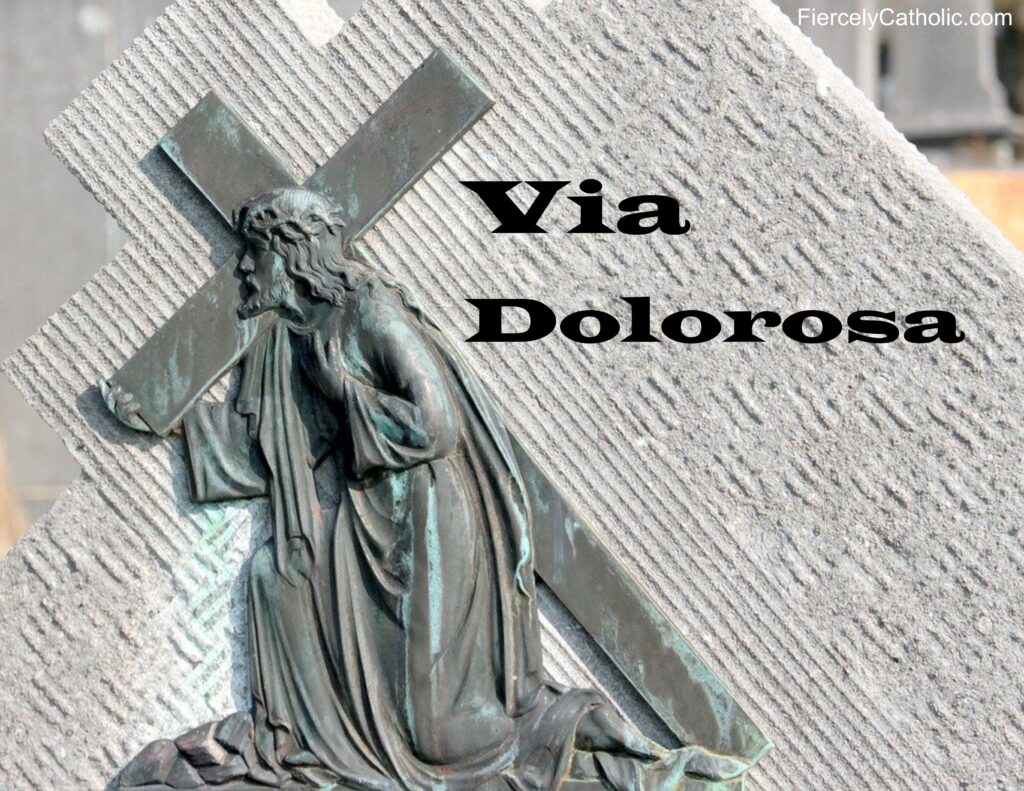
From the earliest days of the Church, faithful Christians have made trips to the Holy Land to follow the footsteps of Jesus on the actual path to his Crucifixion where He gave his life for our salvation.
These pious people would stop along the way to say specific prayers and devotions at spots where specific events had occurred as Jesus carried his Cross to Jerusalem to die.
Pilgrimages to the Holy Land could take years and proved to be expensive and even dangerous. They were not possible for everyone so some Catholics created stations outside their own churches based on Sacred Scripture and Apostolic Tradition. Eventually, the stations were moved inside.
Only a simple cross is necessary to mark each station. Any additional images, figures, or other artwork is optional.
The 14 Stations of the Cross are also known as the Way of the Cross or the Via Dolorosa, the Way of Sorrows.
Although they can be prayed at any time, the Stations of the Cross are traditionally prayed as a penance on the Fridays during Lent, especially on Good Friday.
Significant events during Jesus’ Passion and Death:
Remembering Jesus’ last day as a man on earth:
As they led Him away they took hold of a certain Simon, a Cyrenian, who was coming in from the country; and after laying the cross on him, they made him carry it behind Jesus. A large crowd of people followed Jesus, including many women who mourned and lamented Him. Jesus turned to them and said, “Daughters of Jerusalem, do not weep for Me; weep instead for yourselves and for your children, for indeed, the days are coming when people will say, ‘Blessed are the barren, the wombs that never bore and the breasts that never nursed.’ At that time people will say to the mountains, ‘Fall upon us!’ and to the hills, ‘Cover us!’ for if these things are done when the wood is green what will happen when it is dry?” Now two others, both criminals, were led away with Him to be executed.
Luke 23: 26-32
Spiritually accompanying Jesus on the way to Jerusalem:
Christians were naturally drawn to retrace Jesus’ steps:
This evening, in faith, we have accompanied Jesus as he takes the final steps of his earthly journey, the most painful steps, the steps that lead to Calvary. We have heard the cries of the crowd, the words of condemnation, the insults of the soldiers, the lamentation of the Virgin Mary and of the women. Now we are immersed in the silence of this night, in the silence of the cross, the silence of death. It is a silence pregnant with the burden of pain borne by a man rejected, oppressed, downtrodden, the burden of sin which mars his face, the burden of evil. Tonight we have re-lived, deep within our hearts, the drama of Jesus, weighed down by pain, by evil, by human sin.
Pope Benedict XVI, Way of the Cross at the Colosseum, April 22, 2011
Meditating on the suffering of Jesus and his great love:
Expressing our faith in a physical way:
The Stations of the Cross is a prayer:
Recognizing that all of life is a pilgrimage:
The prayer of the Church venerates and honors the Heart of Jesus just as it invokes his most holy Name. It adores the incarnate Word and his Heart which, out of love for men, He allowed to be pierced by our sins. Christian prayer loves to follow the Way of the Cross in the Savior’s steps. The stations from the Praetorium to Golgotha and the tomb trace the way of Jesus, who by his holy Cross has redeemed the world.
Catechism of the Catholic Church 2669
There are different ways of praying the Stations of the Cross:
You won’t find the Stations of the Cross in Eastern Catholic Churches:
The Truth, Goodness, and Beauty of the Catholic Church
The Church is not old:
Share this page with friends and family to start a conversation about your faith.
Don’t miss a post. Learn more about the Catholic Church and strengthen your Catholic faith.
Find more Fiercely Catholic video issues here.
Subscribe here.

